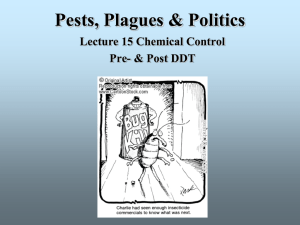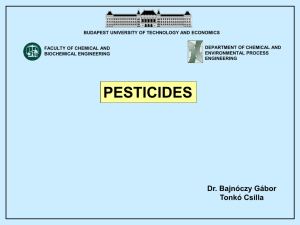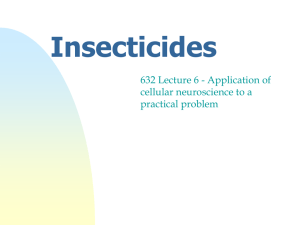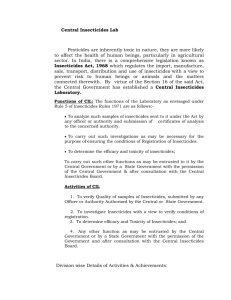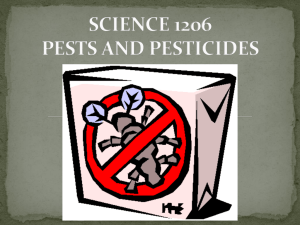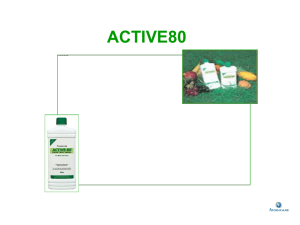Agricultural Chemicals
advertisement
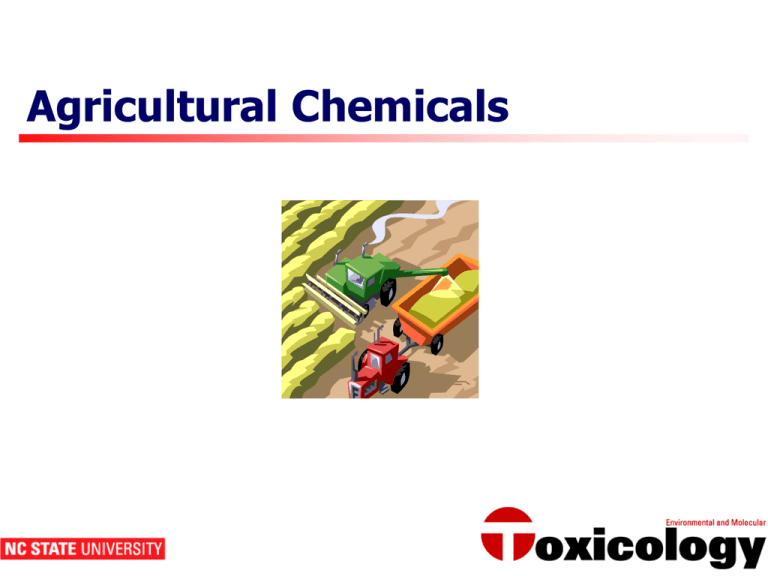
Agricultural Chemicals What is a pesticide? Pesticide Definition Agricultural chemicals: Pesticides ▫ economic poisons: control, kill, repel pests History of Pesticides: Early Ancient Chinese: used arsenic to control insects Early Romans: used common salt for weed control and sulfur for insects History of Pesticides: 1800s Pyrethrin ▫ insecticidal properties discovered Derris elliptica roots ▫ fish poison ▫ isolated rotenone, used for insect control Rotenone History of Pesticides: 20th Century Establishment of organic chemical industry ▫ 1920s: petroleum oils to control spider mites ▫ 1940s: chlorinated hydrocarbon (e.g. DDT) and phenoxy acid (e.g. 2,4-D) insecticides ▫ 1950s: Triazine herbicides (e.g. atrazine) ▫ Late 20th century: synthetic pyrethroids Definitions and Terms US production about 1.2 billion pounds Categories: ▫ ▫ ▫ ▫ ▫ fungicides herbicides insecticides rodenticides fumigants Key Points Unique pollutants in that they are designed to kill Ideally, objective is to be highly selective ▫ destroy target without effects to nontarget organisms Realistically, benefit vs. risk to health and environmental quality are weighed Pesticide Formulations Active ingredient. Formulations: solid or liquid. Adjuvants: adhesives, surfactant spreaders and emulsifiers. Solvents: water, xylene or oil. Terminology Emulsifier Carrier Adjuvant Active ingredient Spreader Surfactant Technical material Other Classification Categories USEPA Use Categories Carcinogenicity Classification Use Category LD50 (mg/kg) Category I ≤ 1.0 Category II 1.0< x ≤ 500 Category III 500 < x ≤ 15,000 Classification Carcinogenic to Humans Likely Carcinogenic to Humans Suggestive of Carinogenicity Inadequate Data Not Likely Carcinogenic to Humans Relevant Laws and Regulations U.S. Code of Federal Regulations (CFRs) ▫ Title 7: agriculture ▫ Title 21: food and drugs ▫ Title 40: environmental protection Relevant Laws and Regulations Insecticide Act of 1910 ▫ Label contents accurate and product works Federal Insecticide, Fungicide and Rodenticide Act of 1947 (FIFRA) ▫ Basic authority for pesticide regulation ▫ Evaluation of risks posed by pesticides ▫ Amended in 1988 for reevaluation of early pesticides with current test protocols ▫ Enforced by the USEPA Relevant Laws and Regulations Clean Water Act (1972) ▫ Permit required for any discharged pollutants Endangered Species Act (1973) ▫ Regulation of pesticide use surrounding wildlife sanctuaries ▫ Concern for transport of chemical to non target organisms Relevant Laws and Regulations Safe Drinking Water Act (1974, 1986, 1996) ▫ Maximum contaminant levels (MCLs) for public drinking water systems established Resource Conservation and Recovery Act (RCRA) (1996) ▫ Regulate transport, storage and disposal of hazardous substances Relevant Laws and Regulations Comprehensive Environmental Response, Compensation, and Liability Act (CERCLA or Superfund) (1980) ▫ Cleanup hazardous waste sites Superfund Amendments and Reauthorization Act (SARA) (1986) ▫ Increased stakeholder involvement and fund size ▫ Seek reimbursement for cleanup costs Relevant Laws and Regulations Worker Protection Standard for Agricultural Pesticides (1994) ▫ Designed to prevent occupational exposures ▫ Employers provide safety training, access to labels, medical treatment ▫ Covers use on farms, forests, nurseries, and greenhouses. Relevant Laws and Regulations Food Quality Protection Act (1996) ▫ Amendment to FIFRA and FFDCA, as applied to food crops ▫ “reasonable certainty of no harm” from residues found on food ▫ Aggregate (multipathway/multimedia) risk ▫ Cumulative (multipollutant) risk Organochlorine Insecticides Organochlorine Insecticides Insecticides containing chlorine ▫ e.g. DDT, heptachlor, dieldrin, aldrin, lindane, chlordane Neurotoxicants ▫ Acute effects caused by interference with nerve transmission along axons Organochlorine Insecticides Major Groups of OCs DDT and its analogs Hexachlorocyclohexane Cyclodienes and similar compounds Toxaphene and related compounds Mirex and Chlordecone Organochlorine Insecticides: DDT 1,1,1-trichloro-2,2-bis(p-chlorophenyl) First synthesized in 1874, but insecticidal properties not determined until 1939 US used during WWII to reduce vector-borne diseases (e.g., malaria, typhus) Widespread agricultural and private use followed owing partly to its persistence Alters sodium-potassium transport across axonal membrane such that repolarization does not occur Rachel Carson’s book Silent Spring published in 1962 led to eventual ban of chlorinated pesticides in 1972 DDT Synthesis DDT Toxicity p,p’-DDT ▫ LD50s: −1.7 mg/Kg in honeybees −113 mg/Kg in rats −205 mg/Kg in Japanese beetles −1296 mg/Kg in pheasants −2000 mg/Kg in bullfrogs DDE and DDD ▫ Very few acute effects. Human Toxicity Environmental Transformation of DDT. DDE Most problematic of all the derivatives of DDT. Very persistent. Bioconcentrates in biota. Main responsible for egg-shell thinning in several bird species. Organochlorine Insecticides: Issues Persistence ▫ Despite ban, continue to be found in the environment Bioaccumulation Potential ▫ Transfer of residue through food chains + environment. Lipophilicity Suspected Carcinogenicity Organophosphorus Insecticides Organophosphorus Insecticides Phosphoric or thiophosphoric acid esters (OPs) ▫ e.g., ethylparathion, chlorpyrifos, parathion, malathion, leptophos Neurotoxicants ▫ Acetylcholinesterase inhibitors, results in excess acetylcholine in nerve tissue and effector organs ▫ Generally low mammalian toxicity (carboxylesterases) ▫ Delayed toxicity, organophosphorus-induced delayed neuropathy (OPIDN) − Paralysis of distal muscles 7-10 days after ingestion Relatively nonpersistent, susceptible to hydrolysis Organophosphorous Insecticides Structure Name LD50 (mg/kg) Ethyl Parathion 3 – 13 Diazinon 250 – 285 Chlorpyriphos > 3000 Malathion 1000 - 1375 Carbamate Insecticides Esters of N-methyl carbamic acid (H2NCOOH) ▫ e.g., carbaryl, aldicarb, propoxur Neurotoxicants ▫ Acetylcholinesterase inhibitors ▫ Inhibition is rapidly reversed in comparison with OPs ▫ High mammalian toxicity Relatively nonpersistent, readily hydrolyzed Carbamate Insecticides Structure Name LD50 (mg/kg) Carbaryl (Sevin) 250 - 550 Propoxur (Baygon) 100 Aldicarb (Temik) ~1 Botanical Insecticides Extracts from plants Nicotine first used as insecticide in 1763 Oral LD50: 83 mg/kg Dermal LD50: 285 mg/kg Respiratory toxicant Nicotine Botanical Insecticides Pyrethrins (6 acids and esters) ▫ extracted from chrysanthemums Low mammalian toxicity Nonpersistent, degraded by heat/light Pyrethroid Insecticides Designed from pyrethrin structure for added photostability Two basic structures ▫ Cyclopropane ring −cypermethrin ▫ No cyclopropane ring −fenvalerate Herbicides Used to control weeds, fairly specific Widespread usage (half of pesticides) Typically inhibit plant specific enzymes ▫ Low mammalian, fish, insect, bird toxicities Continual usage however leads to environmental contamination Herbicides: Agent Orange Combination of 2,4-D and 2,4,5-T Used during Vietnam War as defoliant TCDD identified as a toxicological contaminant in mixture ▫ High mammalian toxicity (0.022 mg/kg) Toxicity of TCDD Related to each individual congener. Toxicities may vary a lot among the different congeners. Toxic equivalency factors: ▫ A representation of the fraction of TCCD toxicity manifested by a group of congeners found in a mixture. ▫ A mixture having 50% of each TCDD and hexaCDD: −total toxicity of 0.505 times the toxicity of Herbicides: Triazines Atrazine, cyanazine, simazine Relatively nontoxic (LD50: 3,100 mg/kg) Readily transport to water systems Possible human carcinogen however Herbicides: Paraquat Member of the bipyridyl family of herbicides Highly water soluble but binds tightly to soil particles Respiratory toxicant following ingestion ▫ LD50: 150 mg/kg Fungicides Used to prevent crop loss and health effects from toxins released by fungi ▫ e.g., chlorothalonil ▫ relatively nontoxic Dithiocarbamates ▫ e.g., mancozeb ▫ relatively nontoxic but hydrolyze to produce carcinogens such as ethylenethiourea (ETU) Rodenticides Used to prevent losses in grain and other food storage facilities Generally restricted use only ▫ e.g., warfarin, an anticoagulant −lack of blood clotting leads to bleeding to death (LD50: 3.0 mg/kg) Rodenticides: Others Fluoroacetamide: supplied as bait pellets or grains ▫ LD50: 15 mg/kg, fast acting ANTU (a-naphthylthiourea) Strychnine Thallium salts Fumigants Used to protect stored products (e.g., grains) and kill nematodes Hazardous due to potential for inhalation exposure (restricted use only) ▫ e.g., methyl bromide ▫ LD50: 0.06 mg/L (inhalation, rat) ▫ Effects include respiratory distress, cardiac arrest, and CNS effects Biocontrol Pesticides Uses “natural” mechanisms for combat ▫ Parasites (Aphytis lepidosaphes, wasp) ▫ Predators (Neoseliulus califirnicus, spider mite) ▫ Attractants (pheromones) Nontoxic to humans Enhanced Seed Uses traditional breeding and genetic engineering to ▫ tolerate herbicides ▫ resist insects and disease Bt (Bacillus thuringiensis) gene inserted into plants Nontoxic to humans however ▫ Genetically modified seed or organism (GMO) controversy References 1-Crosby, D.G. Environmental Toxicology and Chemistry. 2000. Oxford University Press, New York. 2- Hodgson and Levi (Eds), A Textbook of Modern Toxicology, Second Edition. Appleton and Lange, Connecticut, 1997. Additional Resources U.S. EPA on pesticides: http://www.epa.gov/ebtpages/pesticides.htm l Code of Federal Regulations: http://www.access.gpo.gov/nara/cfr/ The Endangered Species Act: http://endangered.fws.gov/esa.html Credits Lecture Slides contributed by: ▫ Dr. Ross B. Leidy ▫ Dr. Alicia Chaves Online lecture prepared by: ▫ Dr. Alicia Chaves ▫ Dr. Stephen Graham

